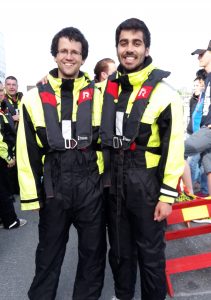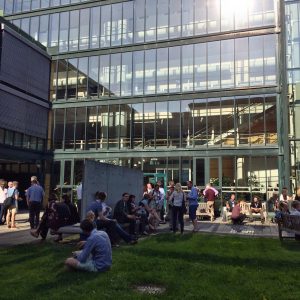Networking and exchanging ideas is undoubtedly one of the major reasons for attending a conference. And yet, many PhD students (including us) are often shy about approaching the leaders and visionaries of our research field. This year, we decided to change our behavior: we challenged ourselves to finally start conversations with some invited speakers.

Flo and Juan ready to talk to the bigwigs.
The conference “Molecular Mechanisms of Inflammation” in Trondheim was ideal for that purpose. With its relatively small size of about 220 participants, it still hosted a good number of big names from the field of innate immunity. Social events, like a speed boat tour, provided opportunities to catch PIs in a more relaxed setting outside of the short conference breaks. To make our task easier, we devised the idea to interview the big wigs about the past and the future of innate immunity. We hoped to get some insights into the mind of successful PIs, but did not expect anything beyond that. However, we were positively surprised because we got so much more than this: many extremely friendly conversations that lasted a lot longer than just our interview, one job offer, one hug and one shout-out at the conference gala dinner.
We interviewed Richard Flavell, who works on both the innate and adaptive side of immune responses; Kate Fitzgerald, known for her work on the molecular details of PRR signaling; Lynda Stuart, a Senior Program Officer at the Bill and Melinda Gates Foundation; Alan Sher, known for his work on Toxoplasma and Mycobacterium tuberculosis; and Paul Hertzog, who was introduced to us as the master of interferons.
Our first question was which discovery in the field of molecular mechanisms of immunity they thought was the most important within the last 50 years. Most of the answers we got were not that surprising: the TLRs – there was a reason for that Nobel Prize. The identification of specific receptors on innate immune cells also meant that they were not only considered “non-specific immunity” anymore. Lynda Stuart pointed out the work of Charles Janeway on the interaction of adaptive and innate immunity to recognize “non-self”, and Polly Matzinger’s definition of endogenous danger associated molecular patterns (DAMPs). Our outlier in this question was Alan Sher, who pointed us toward the contribution of the microbiome to immune responses.

Enjoying the food and the conversations during lunch break.
Microbiota and their impact on human health also came up when we asked where the field should be going next: Richard Flavell felt that we need to further understand interactions between our immune system, parenchyma and other cell types with each other and also our microbiota. Others pointed out that it was now up to us to deliver a better understanding of human disease and that we should turn our molecular understanding into clinical utility. In this context, Paul Hertzog also suggested that we should move towards precision medicine.
Finally, we asked for some advice for PhD students. And here, everyone told us to follow our passion, or as Kate Fitzgerald put it: “find an important question that you are passionate about, and love doing your research”.
We would like to thank all of the PIs for taking the time to talk to us.
Authors: Florian Hoß, Juan Rodríguez Alcazár and Andrea Stutz
